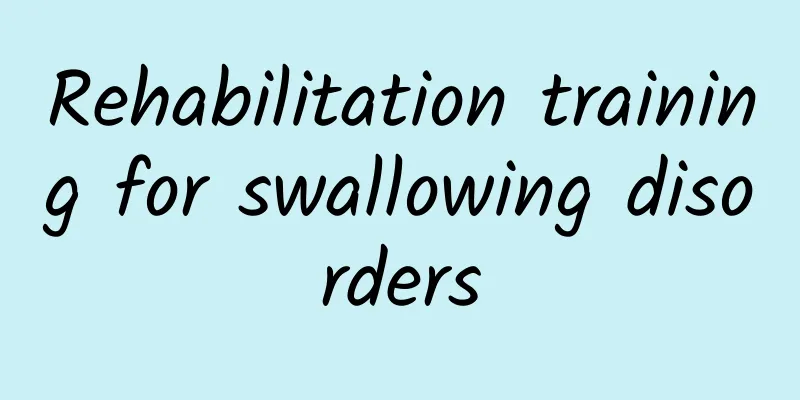Rehabilitation training for swallowing disorders

|
Patients with dysphagia often cannot eat normally, and even have problems with their oral cavity, so they must control it reasonably and choose high-quality methods for treatment. Generally, dysphagia will cause trouble and burden to the body. It starts with basic training, including training of teeth, lips, and refusal methods. Rehabilitation training (1) Before preparing for training, patients should be educated on rehabilitation training. Those with speech disorders can use text, communication boards, or other effective methods. Training should start 30 minutes before meals. Relaxation preparation exercises: Sit upright on a chair or bed, place your hands in front of your abdomen, inhale and exhale 3 times each, shake your head left and right 3 times each, turn your head left and right 3 times each, shrug your shoulders and relax 3 times each, tilt your upper body to the left and right 3 times each. The movements should be gentle. (2) Basic training 1) Exercise training of muscles around the oral cavity: Lip exercises: including closing lips, pursing lips and raising lip corners. The patient closes his lips tightly, and the therapist presses the index finger and middle finger on the upper and lower lips respectively, forcing the lips apart to promote lip closure strength. The patient purses his lips hard, and the therapist places his index finger on the corner of the lips and pulls outward to provide resistance. The patient smiles and the therapist places the middle finger at the corner of the mouth to resist the upward movement of the lip corner. Quickly rub ice cubes along the corners of your mouth toward your cheeks to help lift the corners of your lips. Jaw movement: includes jaw opening and jaw closing. As the patient opens his mouth, the therapist places his hand under the jaw and pushes upward to resist the downward force of the jaw. When closing the jaw, the patient bites hard and the therapist pulls the jaw down to apply opposing force. Tongue movement: including extension, lateral extension, and elevation of the tongue tip and root. Ask the patient to stick out his tongue as far as possible. Use a spoon or tongue depressor to provide resistance. Use a tongue depressor or spoon to apply quick, inward pressure to the middle of your tongue. Stick out your tongue and lick the straw or jelly. When the tongue is extended laterally, use a tongue depressor to provide resistance. The tongue pushes up the cheeks on both sides in the mouth to provide resistance. Place jelly at the corner of the lips and have the patient lick it with the tongue. Use the tip of your tongue to clean your teeth in clockwise and counterclockwise motions. Use the tongue depressor to push down quickly and forcefully on the base of the tongue, then use the tongue depressor to resist lifting the base of the tongue. Pronouncing the "k" sound also helps to raise the root of the tongue. 2) Cold stimulation method: ① When the swallowing reflex is weakened or disappears: use a frozen cotton swab to gently stimulate the soft palate, palatine arch, tongue root and posterior pharyngeal wall to increase the sensitivity of the soft palate and pharynx, making the swallowing reflex easier to occur. ② Countermeasures for drooling: Massage the salivary glands on the neck with ice until the skin turns slightly red. 3 times a day, 10 minutes each time 3) Breath-holding and vocalization exercises: The patient sits on a chair, supports the chair with both hands and does pushing exercises, holding his breath. Then suddenly let go and pronounce the "a" sound loudly and forcefully. It can also be changed to push the wall. Or when the patient tries to make a sound, the therapist puts his hands on the patient's shoulders in front to apply pressure. When making a sound, the patient pushes his body forward and resists the therapist's hands. This exercise can train the glottic closure function, strengthen the soft palate muscles, and help remove food remaining in the pharynx. 4) Cough training: The patient coughs repeatedly to clear the throat to promote the effect of laryngeal closure. 5) Articulation training: The patient opens his mouth to pronounce the "a" sound, then moves to the sides to pronounce the "yi" sound, and then the "wu" sound, each sound is pronounced 5 times each time. You can also ask the patient to purse his lips and make a "hu" sound, like blowing out a candle or a whistle. Further let the patient make simple sounds of "you, me, him". Then sing a song that you are most familiar with, and encourage singing loudly. By opening and closing the mouth and the glottis, the movement of the lip muscles and the locking function of the glottis can be promoted. 6) Breathing training: Control your breathing ability by extending your inhalation and exhalation. For specific procedures, please refer to the respiratory diseases section. 7) Breath-holding and swallowing: Loss of vomiting reflex, coughing reflex, and vocal cord paralysis can easily lead to aspiration pneumonia. It can improve the eating process, perform supraglottic swallowing, and prevent accidental swallowing. The method is: chew - inhale - hold breath - swallow - cough - swallow. 8) Sucking and laryngeal lifting training: The patient puts a rubber glove on the index finger and places it in the therapist's mouth, and the therapist sucks the finger. The patient then places his or her finger in his or her mouth, imitating the sucking action and experiencing the feeling of sucking. Practice repeatedly until you develop moderate sucking power. The patient places his or her fingers on the upper edge of the therapist's thyroid cartilage and feels its movement as the therapist swallows. The patient then places his or her own fingers on the thyroid cartilage, mimicking the action. |
<<: What is the most effective way to treat toothache?
>>: What should I pay attention to after I just took off the ring?
Recommend
Young and sick
Nowadays, many young people are almost always sic...
Spinal muscular atrophy
Generally speaking, this disease is a recessive g...
What are the symptoms of hand-foot syndrome
The cause of hand-foot syndrome is usually due to...
3 tips to improve hoarseness caused by pharyngitis
Pharyngitis is a common throat disease in daily l...
How long after wisdom teeth removal can I smoke?
Wisdom tooth extraction is the most common dental...
Detailed steps of cesarean section
Cesarean section is a method of delivery. For wom...
What are the symptoms of cerebral cortical atrophy?
The most common cause of cerebral cortical atroph...
Damage to teeth caused by tooth nerve killing
Toothache can sometimes be an unbearable condition...
What are the effects of stone frog
The stone frog is relatively large in size compar...
Fulonggan Alias
Fulonggan, the name of a Chinese herbal medicine....
Treatment of cervical spinal stenosis, scientific treatment and good recovery
Cervical spinal stenosis can cause symptoms of ne...
What is human immunoglobulin
There are many types of medicines, and you cannot...
What are the medicinal uses of yew?
The yew plant, which is currently on the verge of...
Does a stroke have sequelae?
I believe everyone is familiar with cerebral infa...
What to do if the vulva is itchy, painful and swollen
Itch, pain and swelling of the vulva is a symptom...









